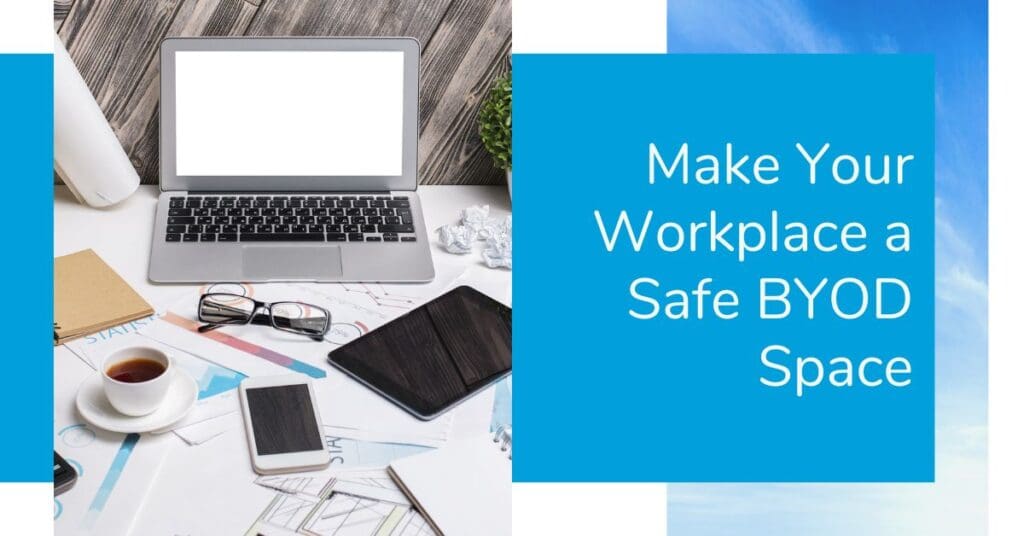Best Practices for Implementing a Secure BYOD Environment

Cybersecurity and protecting data is a top priority for many business owners. It’s for this reason that implementing a bring your own device (BYOD) policy remains both a major opportunity and challenge for enterprises. By following the right approach to identifying BYOD risk and developing effective BYOD policy, it is possible to capitalize on the benefits of a BYOD environment without adding significant risk. Today, 85 percent of organizations allow employees to use personal devices for work and that number will only grow.
Before you turn your employees loose with their smartphones and tablets, you have to lay some ground rules. Most companies lack the resources to effectively manage a BYOD environment. Allowing many different devices, operating systems and software versions in the same corporate environment can quickly stretch your IT resources too thin. Writing and enforcing a comprehensive BYOD policy is the best way to protect your organization. When executed correctly, creating a corporate BYOD environment with a strict security policy will far outweigh any potential risks.
How a BYOD Security Policy Helps Your Business
Defining a BYOD security policy is a critical step in maintaining company security when employees are bringing their personal devices to the workplace. TechTarget outlines a few essential elements of a BYOD policy, including:
- Acceptable use. What applications and assets are employees permitted to access from their personal devices?
- Minimum required security controls for devices
- Company-provided components, such as SSL certificates for device authentication
- Company rights for altering the device, such as remote wiping for lost or stolen devices
Specifying the permissible device types and establishing a stringent security policy for all devices are simple measures that can enhance company security. For example, consumers may opt out of utilizing native security features such as the ability to lock device screens or the requirement of passwords because these features create additional steps that inconvenience users. Employees, however, are more motivated to make use of these simple features because of the clear company policies that exist. Additionally, employees feel more comfortable and productive working on familiar devices, and BYOD cuts down on device and software costs.
3 Best Practices for a Successful BYOD Environment
Create Employee Awareness
BYOD policies are only successful if your employees understand the requirements. Therefore, it’s critical that user training introduces employees to security and policy guidelines and, above all, allows IT and leadership to set clear expectations. Essential elements of BYOD environment training include:
- The rationale of BYOD and what it means to your organization
- An onboarding BYOD device process
- Data ownership policies (e.g., corporate vs. personal email, social network access)
- How to access corporate applications and assets from a BYOD device (e.g., virtual private network [VPN], corporate email)
- BYOD device security policies
- Technical support and escalation paths
- Roles and responsibilities of BYOD users
- Employee expense reimbursements and/or stipends (or lack thereof)
Address Vulnerabilities and Risks
Mobile devices are no longer just communication tools. From maps to social networking to productivity tools to games, apps change the way we feel and interact with computing. Although apps provide a whole new level of innovative experiences, they also increase the security risk in a BYOD environment. The security risks associated with apps can be in:
- Malicious apps (malware). The increase in the number of apps on the device increases the likelihood that some may contain malicious code or security holes
- App vulnerabilities. Apps developed or deployed by the organization to enable access to corporate data may contain security weaknesses
To effectively counter these risks, consider the following best practices:
- Utilize services that enable data sharing between BYOD devices
- Protect both company-issued and BYOD devices by using a standardized mobile antivirus program
- Manage apps through an in-house app store or a mobile app management product
- Ensure that BYOD security policies cover mobile app development and download
- Assess the need for new apps continuously to increase productivity and security
- Leverage third-party experts to bridge assessment skills gaps
Partner With a Trusted Advisor
Partnering with the right cloud managed service provider gives your organization a competitive edge. For the best protection in a BYOD environment, it’s best to utilize the cloud to avoid storing information locally. Selecting the most suitable cloud solution for your needs can be daunting, especially with so many options now available and the added complexity of BYOD.
At SkyTerra, our clients count on us for reliable and redundant data backup, rapid and comprehensive security and rock-solid disaster recovery. We also understand that having your data off-site can feel scary. We protect it with proven cybersecurity practices:
- Cloud data backup
- Disaster recovery
- End-to-end encryption
- Cloud protection and security
- Office 365 migration
For a sound technology infrastructure and secure BYOD environment, contact us today or book a meeting to speak with a trusted security and cloud advisor.
